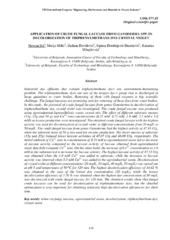Приказ основних података о документу
APPLICATION OF CRUDE FUNGAL LACCASE FROM GANODERMA SPP. IN DECOLORIZATION OF TRIPHENYLMETHANE DYE CRYSTAL VIOLET
| dc.creator | Ilić, Nevena | |
| dc.creator | Milić, Marija | |
| dc.creator | Davidović, Slađana | |
| dc.creator | Dimitrijević-Branković, Suzana | |
| dc.creator | Mihajlovski, Katarina | |
| dc.date.accessioned | 2023-08-23T09:14:42Z | |
| dc.date.available | 2023-08-23T09:14:42Z | |
| dc.date.issued | 2023 | |
| dc.identifier.isbn | 978-99955-81-45-9 | |
| dc.identifier.uri | http://TechnoRep.tmf.bg.ac.rs/handle/123456789/6605 | |
| dc.description.abstract | Industrial dye effluents that contain triphenylmethane dyes are environment-threatening problem. The triphenylmethane dyes are one of the largest dye’s group that is discharged in large quantities to water bodies. Removing of them with fungal enzymes is big scientific challenge. The fungal laccases are promising tool for removing of these dyes from water bodies. In this study, the potential of crude fungal laccase from genus Ganoderma in decolorization of triphenylmethane dye, crystal violet was investigated. The crude fungal enzyme was produced using agroindustrial lignocellulosic waste, cereal mix. The effect of different substrate masses (15g, 25g and 50 g) and Cu2+ ions concentrations (0.25 mM, 0.75 mM, 1.0 mM, 2.5 mM и 5.0 mM) on lccase production were investigated. The obtained crude fungal laccase with the highest activity was used for decolorization of crystal violet at different concentrations from 20 mg/L to 50 mg/L. The crude fungal laccase from genus Ganoderma had the highest activity of 47.43 U/g, when the substrate mass of 50 g was used for enyzme production. The lower masses of substrate (15g and 25g) induced lower laccase activities of 45.07 U/g and 46.69 U/g, respectively. The initial addition of Cu2+ ions in concentration of 0.25 mM to agroindustrial waste led to decrease of laccase activity compared to the laccase activity of laccase obtained from agroindustrial waste that didn’t contain Cu2+ ions. On the other hand, the increase of Cu2+ concentration to 1.0 mM in the substrate led to increase the laccase activity. The highest laccase activity of 47.53 U/g was obtained when the 1.0 mM Cu2+ was added to substrate, while the decrease in laccase activity was observed when 5.0 mM Cu2+ was added to the agroindustrial waste. Decolorization of crystal violet at different concentrations (20 mg/L, 30 mg/L, 40 mg/L, 50 mg/L) was carred out at pH 5 and temperature of 50 ºC for 120 min. The highest decolorization efficiency of 14.42 % was obtained in the case of the lowest dye concentration (20 mg/L), while the lowest decolorization efficiency of 3.76 % was obtained when the highest dye concentration of 50 mg/L was decolorized with crude fungal laccase for 120 min. The obtained results show that fungal crude laccases can be used for decolorization of triphenylmethane dyes, but the detailed optimization is very important for obtaining relatively high decolorization efficiencies for short time. | sr |
| dc.language.iso | en | sr |
| dc.publisher | Zvornik : University of East Sarajevo Faculty of Technology | sr |
| dc.relation | info:eu-repo/grantAgreement/MESTD/inst-2020/200287/RS// | sr |
| dc.relation | info:eu-repo/grantAgreement/MESTD/inst-2020/200135/RS// | sr |
| dc.rights | openAccess | sr |
| dc.rights.uri | https://creativecommons.org/licenses/by/4.0/ | |
| dc.source | Proceedings / VIII International Congress "Engineering, Environment and Materials in Process Industry", EEM2023, Jahorina, March 20-23 | sr |
| dc.subject | white rot fungi | sr |
| dc.subject | laccase | sr |
| dc.subject | agroindustrial waste | sr |
| dc.subject | decolorization | sr |
| dc.subject | triphenylmethane dye | sr |
| dc.subject | crystal violet | sr |
| dc.title | APPLICATION OF CRUDE FUNGAL LACCASE FROM GANODERMA SPP. IN DECOLORIZATION OF TRIPHENYLMETHANE DYE CRYSTAL VIOLET | sr |
| dc.type | conferenceObject | sr |
| dc.rights.license | BY | sr |
| dc.citation.epage | 186 | |
| dc.citation.spage | 179 | |
| dc.identifier.fulltext | http://TechnoRep.tmf.bg.ac.rs/bitstream/id/17778/Application_of_crude_pub_2023.pdf | |
| dc.identifier.rcub | https://hdl.handle.net/21.15107/rcub_technorep_6605 | |
| dc.type.version | publishedVersion | sr |

